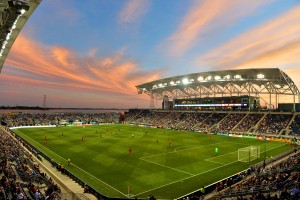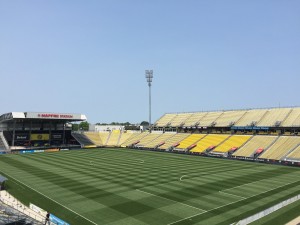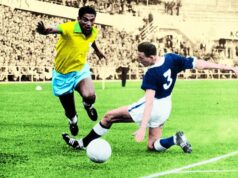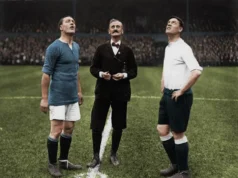
PPL Park – Philadelphia Union
Some of the best natural grass athletic surfaces in the world are harbored in Major League Soccer (MLS).
To continue networking and exchanging ideas, the inaugural MLS Groundskeepers Conference was hosted at this year’s Sports Turf Managers Association (STMA) Conference & Exhibition in San Diego, Calif., further demonstrating industry collaboration with 15 of 20 teams represented.
Many STMA members have attained status as a Certified Sports Field Manager (CSFM), a title where you are looked upon as a leader in the industry. Recently, the organization eclipsed 200 CSFM’s.
With soccer season underway, we caught up with some of the best in the business to hear about their secrets to success.
Participants (arranged alphabetically by last name):
- Weston Appelfeller, CSFM, Director of Grounds at Columbus Crew SC and Elected-at-Large Director of STMA
- Shaun Ilten, Director, Turf and Grounds at LA Galaxy
- Allen Reed, CSFM, Director of Stadium Grounds at FC Dallas
- Dan Shemesh, Director of Grounds at New York Red Bulls
- John Torres, Head Groundskeeper at Philadelphia Union
What is something unique about your field that most fans would not know?
APPELFELLER: The field at MAPFRE Stadium has only been replaced once since 1999. We have 2-4 concerts per year, as well as soccer and football events regularly. This is due to the efforts of many individuals that have worked on our pitch since its inception.
ILTEN: During the spring months our field consists of a Bermuda base overseeded with ryegrass; in the summer it is 100% Bermuda.
REED: We have a permanent stage on the north end of our stadium. This is one of the stadium design features I like the best. It allows us to host concerts during the season between soccer matches without damaging the pitch.
Most venues spend the week prior to a concert building a stage on the field, the week after breaking it down and another week repairing damage from the stage. As a result, concert set up and breakdown for us occurs in less than 72 hours and the flooring on the pitch takes less than 55 hours. This feature is a lifesaver when it comes to protecting the playing surface and being able to host multiple types of events consecutively with minimal damage to the field.
SHEMESH: The most unique aspect of our field is how we utilize a growing light system in order to maintain a high quality playing surface.
We own four large and small rigs with a total of 285 light bulbs that we move around to treat most areas of the pitch. The partial roof creates an unrivaled fan experience, but the tradeoff is decreased hours of natural sunlight.
TORRES: I remember one scenario where we had a torrential downpour of rain and the field flooded to a point where you could not see any grass. Two hours later, the rain had completely drained, leaving a playable pitch. It is truly a testament to the quality of our natural grass playing surface at PPL Park.

StubHub Center – LA Galaxy
How many hours do you spend a week preparing and painting the surface prior to a home game?
APPELFELLER: Our team spends about 30-35 hours per week preparing and painting prior to a home game.
ILTEN: The pitch is mowed daily and usually takes about one hour and 45 minutes.
On gameday, the playing surface is mowed, painted and the goals and static boards are set up. We are usually at the stadium seven hours before kickoff to ensure that we are finished prior to VIP gates opening, which is generally less than two hours before kickoff.
Typically, painting the field takes about one hour and 30 minutes.
REED: Everything we do to the pitch is in preparation for our next home match.
The team will train on the stadium pitch two days prior to a home match. This allows us time to repair any damage from their training session. We will spend that afternoon and all of the next day preparing the playing surface.
Our work can include aerating the pitch with solid tines if needed, divot work and painting and setting goals. If I had to estimate the number of hours we spend preparing the field, I would say with three crew members it requires a total of 10 hours.
SHEMESH: As soon as the field clears after a match we immediately prepare for the next contest.
We conduct a full-field walk for divot repair and clean up mowing post game takes about two hours. We also set up our growing lights before we leave for the night which only takes about 30 minutes with the crew size we have for match days.
The rest of the week the playing surface can receive an additional five mows, two grow light position moves, liquid fertilizer application, hand watering, a possible training session and restriping of the lines. Ultimately, it averages out to three hours per day of actual on-field work.
TORRES: The week leading up to a game, our staff dedicates a minimum of 40 hours per week to maintaining the natural grass playing surface. Generally, we average anywhere from 50-60 hours per week.

Red Bull Arena – New York Red Bulls
Can you provide a brief overview of your daily routine?
APPELFELLER: We walk the field each morning to look for any problem areas. After, we mow the pitch. Depending on the day, we may spray the playing surface with either fertilizer or fungicides. We practice a form of aerification once a week and also edge the field weekly / handle other various tasks each day to make sure it is as strong as possible for any events it faces that week.
ILTEN: I arrive at the stadium 6 a.m., which is 30 minutes prior to the rest of the crew arriving.
I put together last minute requests that have come in the night before and make sure daily lists are set when my staff arrives.
Next, I walk all of the fields in the morning once the crew arrives. There are nine fields that need to be walked, so my assistant helps me as well.
Once the fields are walked I will go and talk to coaches and let them know what my maintenance plan is for the day or week, depending on their schedule. If they have any questions, comments, or concerns, we address them then.
Once training is finished, we walk the pitch to fill divots, while also aerfiying if needed.
Then, I ensure sure that my staff have the necessary tools for the job that I have asked them to complete. I will sit down with my assistant and go over what we completed, what is still on the to-do list and prioritize it for the following day. I usually leave the stadium anywhere between 4-5 p.m. on non-event days.
REED: Our daily routine varies considerably between the stadium and training pitch.
We have a weekly routine that we try to follow regardless of which events we are hosting. We always aerate the field on Mondays and use a variety of depths, tines, and aerating machines. We will try to pull cores six times per year, depending on weather and schedule, while using bayonet tines or a form of vertical aeration the rest of the time.
Tuesdays we attempt to stay off of the pitch to let it rest.
Wednesdays we will fertilize with either a liquid or granular fertilizer.
Thursdays and Fridays are used for event setup, whether that is soccer matches, concerts or high school football.
SHEMESH: My daily routine is to first check the latest weather forecast, walk all of the fields so I can see everything, spend time catching up my assistants to go over new plans and changes from yesterday’s planning and finally set up for practice with coaches so we are properly rotating wear.
After, I watch the training session so we can repair divots or drive down to the stadium to work on field maintenance projects, attend meetings or fulfill other office obligations.
TORRES: The most important part of our maintenance protocol is having detailed knowledge of the weekly and daily forecast.
From there, we plan out tasks accordingly. We provide the playing surface with adequate nutrients so that it has strength and durability, along with good color for TV.
Something that is important to remember is mowing stripes which follow MLS guidelines.
We also inspect the surface daily for damage, debris and pests. On game day I always try to do a double cut and afterwards we re-measure and string every line for painting. Finally, international goals are mounted and we’re ready for play.

MAPFRE Stadium – Columbus Crew
What is the best compliment you have received from a player or coach about the field?
APPELFELLER: Each of our players and coaches have been very respectful of what we do. I believe that the most rewarding compliments are the ones that come from the other groundskeepers that we admire. These tend to mean the most because the come from individuals that understand the true grind that this profession can hand us.
ILTEN: We recently resodded the pitch a couple weeks ago and since then have had multiple matches on it.
The Galaxy were the first to play on it, literally 24 hours after the last roll was laid out. The Galaxy coach was very impressed and said that it is the best sod he has seen and it played extremely well.
Right after the last roll was laid we used a 2-ton roller and rolled the pitch to decrease the bumpiness, so the ball roll was true.
REED: I always tell people the best compliment is when the pitch is not talked about. More than likely, if coaches or players are talking about the pitch in their post-game interviews, it’s because something is not right. We all love good compliments, but I know that if nothing is said, all is well.
SHEMESH: It has been rewarding the last few years in regards to hearing the compliments from players and coaches. They see the effort we put in and are very appreciative for everything we accomplish.
One of our previous assistant coaches was in love with our practice fields and proclaimed it the best in North America. It was an honor to hear him say that, but I have travelled around some and know there are amazing fields all over the world associated with major sports teams in tough climates that have high traffic.
TORRES: There are certain occasions where we host non-soccer events such as lacrosse, rugby, etc. and coaches are nervous because they think that the field will be damaged and ruled unplayable. On multiple occasions they’ve said, “John, you’re a magician.”
What is your biggest challenge in managing a natural grass soccer field in MLS?
APPELFELLER: Managing extra events are the hardest part of my job. We understand the damage a MLS match can provide, but the key to my role is limiting the damage from the other events that take place when the team is not playing.
ILTEN: I think the biggest challenge is the time of year in which the MLS season is played. Having concerts during the middle of the season is never ideal, but as a multi-use facility, it is something we adapted to.
Providing the best and safest playing surface is the job of the grounds crew and we are not satisfied until we have achieved that.
REED: As with other soccer venues across the country, we host multiple events on the stadium pitch in-season.
Last year, we hosted 100 events on the stadium field. These events included soccer matches, training sessions, concerts and NCAA and high school football. Most of these events occur every year between March and November, which equals an event every 2.75 days.
It is important for us to communicate with coaches and other front office staff on the significance of protecting the pitch with each event. With our busy schedule we do not have time to resod the pitch between each event. We must take a proactive approach with our maintenance program to prepare the pitch to handle the wear-and-tear of each match or game. When events are being planned, we are always involved before any final decision is made. I love the challenge of hosting all of the events and still being able to produce the same pitch for the player’s week in- and week-out.
SHEMESH: Our biggest challenge is knowing that we need to continue to improve the quality of the field year-round while we add more events, give corporate partners more access and battle extreme weather conditions over the nine month season.
The most action we experience in soccer is during late July with many international teams in preseason. This coincides with the worst time of year for our field because of the high heat and humidity. Another challenge this year is hosting our earliest opening day in seven seasons (March 6), followed by matches every weekend in March.
TORRES: One of the biggest challenges is the unpredictability of the weather. Residing in the Philadelphia area, we experience every extreme weather condition you can imagine: snow, heavy rain, hurricanes, high winds and hot, humid and unbearable heat.
Do you have any notable events coming up this season that you can share with us?
APPELFELLER: We have a three-day rock and roll festival in May which typically draws 30,000-plus people to the stadium each day and lasts 12 hours per day.
ILTEN: We host the CrossFit games in July and will be hosting international matches as well at the end of July. It will be an event packed summer, but having the most dedicated and hardworking staff makes it all possible.
REED: We will be hosting Olympic Qualifying for the U.S. Women’s National Soccer Team and U.S. Men’s National Soccer Team this year. The women will play three matches in February against National teams from Costa Rica, Mexico and Puerto Rico. The men play a winner-take-all match in March against Columbia.
SHEMESH: Our most notable event this year will be a rugby match on March 12 between the London Irish and Saracens. It will be the first rugby match since 2010, so we dusted off and tested out the goal posts over the winter.
TORRES: We will host an eight day stretch starting Memorial Day weekend. It consists of three days of the NCAA Women’s Lacrosse Championship, an MLS match and the Collegiate Rugby Sevens.
Safety is the first priority of sports turf managers but they are also tasked with providing the highest level of playability and visual appeal.
Next time you go to a professional soccer game, take a closer look at the field. You might view it a little differently.
Note: All five MLS groundskeepers interviewed above are members of the STMA, a not-for-profit, professional association for men and women who manage sports fields worldwide. Since 1981, the association and its 34 local chapters have been providing education, information and sharing practical knowledge in the art and science of sports field management. Its more than 2,600 members oversee sports fields and facilities at schools, colleges and universities, parks and recreational facilities, and professional sports stadiums.
For more information: www.stma.org.






